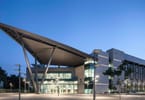Red Sea resort investors, residents and workers in Nuweiba are up in arms fighting the Egyptian Electricity Holding Company-sponsored plan to build a gigantic power plant in the beautiful, pristine resort in South Sinai peninsula.
In the last couple of days, concerned citizens have vehemently opposed the Investment Bank, African Development Bank and top Egyptian Authorities in their joint effort to erect 750-megawatt gas-powered turbines on a site 105,000 square meters in size (and towering over 82 meters in height) right at the heart of the popular resort area of Nuweiba City, South Sinai in Egypt.
Hesham Mustafa Kamel, general manager of the Red Sea Diving Safari in the Shgra Village, Nakari Village and Wadi Lahami Village said they were initially dismayed and shocked to hear that this project has been approved allegedly by the Egyptian Environmental Affairs Agency. However, they have learned later that apparently this is not the case.
Financing is reportedly forthcoming from the European Investment Bank and the African Development Bank – though procedures of the banks and of the European Union for such grants have not been properly adhered to.
If such a plant proceeds, it will have a disastrous effect on the local tourism industry, on the local Bedouin population and, above all, on the local environment, said Kamel and the growing list of petitioners headed by D&S Pikarski, A.J.Furrer and a host of foreign and local investors in Nuweiba.
Nuweiba is one of the most picturesque parts of the whole southern Sinai Peninsula. It has progressive and unique tourism potentials being the home to two major Sinai Bedouin tribes, and the site for the world’s most unique, relatively undisturbed underwater marine life.
According to the petition that’s currently actively soliciting signatures, apart from the obvious enormous detrimental effects such a project will have on the local environment and population during the construction period, once operational, the plant will have a negative impact on the quality of air. It will reduce the level of sunlight, increase noise pollution and, above all, will seriously damage and irreparably wipe out all marine life and coral reefs that lie all along the east coast of Nuweiba adjacent to where the plant is planned to be built. The increase in water temperature will damage the aquatic life in Nuweiba in a number of ways, most prominently by causing a rapid reduction in the number of different fish species found here, causing the death of some and by forcing others to move to distant stretches of reef, but also by inducing coral bleaching and rapidly increasing the amount of algae in the water. This effect will initially be localised to the reefs in the immediate vicinity of the plant, but will, over time, extend to destroy more and more of the reefs in Nuweiba and further afield.
“The large power plant will also cause the eventual demise of the local tourist industry and subsequently force the closure of the hotels, dive centers and other tourist service providers in the area, resulting in the loss of jobs for the many workers within the tourism industry and the loss of livelihood for the various local businesses that supply products and services to the tourism industry in Nuweiba. Tourism is a major source of income for the local Bedouin tribes so the effects on the loss of this industry are simply unimaginable,” said the petitioners en-masse.
At the heart of Sinai, the pristine and almost virgin Nuweiba is located just under one hour from the popular spots such as St. Catherine’s Monastery and Mount Moses in Sinai. It also prides itself as a new name on travel brochures in South Sinai, joining Dahab, Taba in South Sinai, and Marsa Allam on the Red Sea as the driving force behind diving/beach tourism.
The group of petitioners summon concerned individuals, divers, environmentalists, etc. to put pressure on the Ministry of Electricity and Energy, the Egyptian Electricity Holding Company, the South Sinai Governorate, the European Investment Bank, the African Development Bank and the Egyptian Environment Affairs Agency to immediately withhold approvals for this project pending full investigation, in coordination with internationally recognized environmental protection agencies. They also ask to hold full disclosure meetings and consultation with local residents, businesses and NGOs as this has apparently not been done.
After all, the highways to Nuweiba were not built for the purpose of the power plant. Two-lane roads to South Sinai, about 196 kilometers long were built at a cost of $19.97 million in tandem with the state policy for the development of the South Sinai Peninsula. Dual-lane road Ras-Nasrani in Dahab near Nuweiba covers over an area 80 kilometers long, costing $8.33 million. The new road serves as main artery connecting remarkable tourist sites in Sinai, as well as an outlet for seaports on the Gulf of Aqaba. The roads underwent an overall upgrading previously, the pavement extended from 6 to 7.5 meters wide. Certainly, roads enhanced a broader range of services to tourists to Egypt. Infrastructure had been an issue in the Dahab-Nuweiba tourist promotion – the long drive to the resorts from airports, ports or the city, being the stumbling block. New highways to Sharm El Sheikh were completed to level Nuweiba up with the entire Sharm destination viewed as upscale elsewhere in the world.
Now the government is turning it into a power plant?
Proponents of power plant placed an ad in the top local paper Al Ahram Newspaper with very few details on the project and with the instruction that any interested parties should visit certain offices either in Cairo, 470 km away, or Ismailia, 400 km distant, or attend a meeting on the 15th April 2009 in Sharm el Sheikh, 160 km), but made no other serious attempts to advise, consult or inform the local community.
This is not the first time a power plant gets booted out by the locals. Some five years ago, tourism investors, businessmen and environmentalists were at loggerheads over one of the richest coral reef areas in the world, Giftun Island near Hurghada on the Red Sea.
Former prime minister Atef Ebeid and former tourism minister Mamdouh El Beltagui brokered a deal selling Giftun island to Italian multi-million dollar real estate and design firm Ernesto Preatoni Immobiliare (EPI). They asked for $2 billion to paid over 10 years.
Within hours, from Cairo to Hurghada, people staged huge demonstrations. A mini revolution sparked to save marine life and the island.
WHAT TO TAKE AWAY FROM THIS ARTICLE:
- “The large power plant will also cause the eventual demise of the local tourist industry and subsequently force the closure of the hotels, dive centers and other tourist service providers in the area, resulting in the loss of jobs for the many workers within the tourism industry and the loss of livelihood for the various local businesses that supply products and services to the tourism industry in Nuweiba.
- The increase in water temperature will damage the aquatic life in Nuweiba in a number of ways, most prominently by causing a rapid reduction in the number of different fish species found here, causing the death of some and by forcing others to move to distant stretches of reef, but also by inducing coral bleaching and rapidly increasing the amount of algae in the water.
- In the last couple of days, concerned citizens have vehemently opposed the Investment Bank, African Development Bank and top Egyptian Authorities in their joint effort to erect 750-megawatt gas-powered turbines on a site 105,000 square meters in size (and towering over 82 meters in height) right at the heart of the popular resort area of Nuweiba City, South Sinai in Egypt.






















